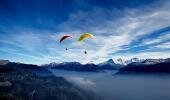Words & Photos: Xen & Adri Ludick
Xen and I love to travel the roads less travelled because getting lost and the overriding joy of getting out of a situation, as well as spur-of-the-moment decisions, are all part of the greater adventure. In fact, many of our unplanned diversions have led to the discovery of wonderful surprises and experiences.
Many special memories and entertaining stories have come from travelling on the Hunters Road on the Zimbabwe/Botswana border, travelling to Vilancoulus on the back road from Mapai via the Banhine National Park, visiting Kaokoland/Damaraland and, of course, the road up North through Zambia and into Malawi, to return via Mozambique. One of our best 'unplanned' experiences happened when we were travelling past Purros, in Namibia, and decided to take a drive up to the viewpoint on the Skeleton Coast. As we stood on Mt. Kabere, with a gale force wind trying to toss us into the valley below, we could see all along the rugged coastline from the south to the north, and from the Khumib River all the way to the east; the view was spectacularly wild, and it was an experience we wouldn’t trade for the world. But it was our Lake Xau discovery made more recently that I would like to share with you.
We’ve been incredibly fortunate to be able to visit the Central Kalahari Game Reserve (CKGR) for some years now, and our route of choice is to travel from Serowe to Orapa, through Mopipi, and then on to Rakops. Just outside of Rakops, we turn left onto the 47 km twee-spoor that leads to the Matswere entrance gate at CKGR. On our last visit, we had to return to Rakops to re-fuel and as it so often happens there was no fuel to be found there. This left us with no option but to continue on to Mopipi, 75 km further on the tar road. To get there we needed to cross the Boteti River, and although we have made this crossing on numerous occasions we’ve never experienced the high water levels as on this particular day. Although the water had risen quite high against the bridge, we were in no danger at any time. Relieved, we set off once more towards Mopipi. On the way, our GPS showed that Lake Xau was close by, and as we had never been to this so-called lake, we decided to check it out after re-fueling.
With our fuel tank full and having found a supply of ice we left Mopipi and turned west, travelling on a gravel road for about 26 km before turning north again. Getting to the western part of the lake was more interesting in Old Faithful, our trusty Land Cruiser, as the road was extremely rocky and became more uneven due to the area being covered by water some weeks back and now the mud had hardened, making the journey a bit rougher. Xen’s extensive driving skills were put to the test, but we managed to progress at a snail’s pace until we reached a secondary track. About 3 km further along there was a gravel area that looked like a small dam, but there was no water in sight. Was this the lake? It wasn’t, and not much further we came upon the real Lake Xau, which is also known as Dow Meer or Lake Dow. It was so huge that we could only just make out the end of the lake. When reading about it later, we learnt that this was the first time it had been filled with water in 40 years!
The principle stream is the Okavango River, which flows from Angola into Botswana and drains into the Okavango Delta. During the rainy season the flow continues east along the Boteti River to Lake Xau and the Makgadikgadi Pans. The lake is approximately 15 km long and 6 km wide, and according to GeoInformation, Lake Xau is a remaining part of an ancient super lake in what is now the Kalahari. This super lake dried out about 10,000 years ago, leaving behind the Makgadikgadi Pan System, Nxai Pan, Okavango Delta, Mababae Depression and Lake Xau. According to Professor Cornelis Vanderpost, the Boteti River was diverted in the 1970s to bypass Lake Xau and bring water to the Mopipi Dam, from where it was pumped to the diamond mine in Orapa. The diversion works around Lake Xau were removed a few years ago and so the original flow pattern of the Boteti River was restored. During the high floods of 2010 and 2011 in the Okavango, the Boteti River reached Lake Xau at the end of June 2011. So when we saw Lake Xau in May 2012, what had once been a decades-old dust bowl was now filled with water and had grown to a considerable size. According to BirdLife Botswana, there is growing interest in birdwatching at Lake Xau as it remains a unique and isolated body of water, and thousands of ruffs have made it their winter home. The ruff (Philomachus pugnax) is a medium-sized wading bird that breeds in marshes. This highly gregarious sandpiper is migratory and sometimes forms huge flocks in its winter grounds, which includes Africa.
Back on the road again we passed Kedia, a small township on the southern part of Lake Xau, and the Gidiwe Pan, and then made our way along the cutline back to the Matswere Gate, all without passing another vehicle. Old Faithfull had once again stayed true and treated us well, taking us safely back to our camp where we reflected on another very special, unplanned day that delivered a worthy reward for choosing the road less travelled. Until next time, safe travels.




